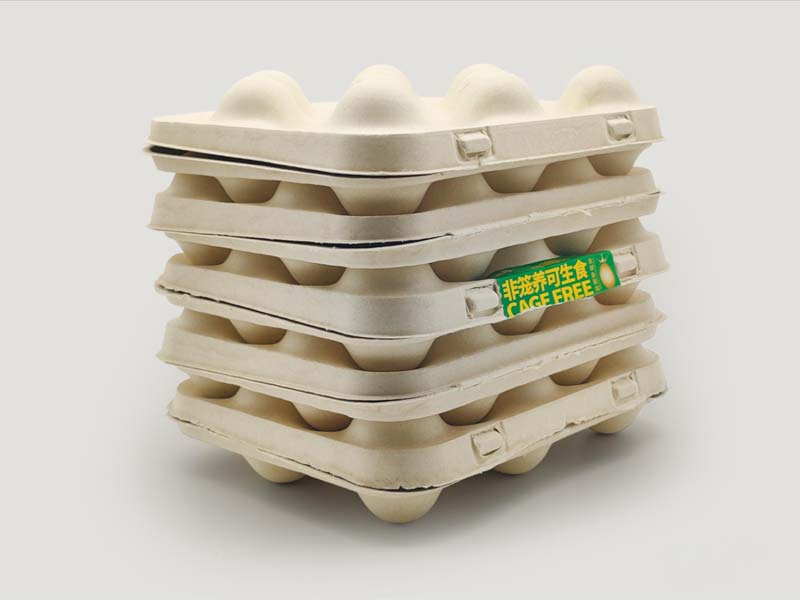Egg tray is a tool used to hold poultry eggs, with the appearance of a tray distributed with grooves, which are used to hold the eggs. The emergence of egg trays greatly facilitates the sales, storage, and transportation of various poultry eggs, providing many conveniences for people’s daily lives. According to different manufacturing materials, egg trays can be divided into pulp egg trays, plastic egg trays, foam plastic egg trays, and so on. Because pulp egg trays are mainly made from waste newspapers and cardboard boxes, which can be recycled and degraded, and are green and environmentally friendly, they are gradually replacing plastic egg trays and becoming the most popular type of egg tray worldwide.
However, although pulp egg trays are all made from pulp materials, they can be further divided into various types of materials, such as waste paper recycled pulp, virgin wood pulp, etc. Egg trays made from different pulps also have different product performance. Therefore, egg tray manufacturers need to consider their production costs, product characteristics, market demand, and other factors comprehensively when choosing suitable raw materials. In this article, we will provide a detailed introduction to several manufacturing materials of pulp egg trays and their characteristics.
Recycled Pulp
Recycled pulp is currently the most widely used raw material in the egg tray making industry. It is made from waste paper products such as old newspapers, magazines, and cardboard through crushing, screening, concentration and other steps. The fibers in recycled pulp are relatively short, which makes the egg trays made are soft in texture and weaker in terms of strength and durability compared to wood pulp and straw pulp.
However, compared to other types of pulp, the manufacturing process for recycled pulp is relatively simple and the raw materials are easily obtainable. Therefore, using recycled pulp to make egg trays has a lower cost and the resulting products are more affordable, which is why it is so popular in the industry. Moreover, the materials used in recycled pulp are entirely recycled waste paper products, providing significant environmental advantages.
Another advantage of using recycled pulp to produce egg cartons is that the waste paper pulp still contains certain substances such as cellulose and lignin, which have natural waterproof and heat-resistant properties that can provide a certain degree of protection for the egg trays. Additionally, the short fiber length of recycled pulp allows for better penetration and absorption of chemical substances such as waterproofing, flame-retardant, and heat-resistant agents during the pulping process, thereby enhancing the waterproof and heat-resistant properties of the egg trays.
Virgin Wood Pulp
Virgin wood pulp refers to pulp made from wood as raw material through chemical or mechanical pulping. Depending on the properties of the raw material, virgin wood pulp can be divided into hardwood pulp and softwood pulp. Hardwood, usually also known as broadleaf trees, includes species such as eucalyptus, poplar, and birch. Softwood, usually also known as coniferous trees, includes species such as pine. The main difference between these two types of pulp is the different performance they exhibit when used in paper. Hardwood fibers are thick and short, and the resulting paper is thick, hard, and is very suitable to be used as packing paper. Softwood fibers are long and thin, resulting in paper with good flexibility, high folding endurance, and good printing performance. Therefore, the wood pulp used in egg tray production is usually hardwood pulp.
Compared with recycled pulp, the fibers of hardwood pulp are harder, and the resulting egg trays are more sturdy and durable, and less likely to deform. However, the production cost of wood pulp is higher, which leads to high prices for the egg trays produced and reduces their market competitiveness. This is why few companies currently use wood pulp to produce egg trays.
Sugarcane Bagasse Pulp
Sugarcane bagasse is a by-product of sugar mills and a typical raw material for papermaking fibers. Sugarcane is a stem like plant that can grow in just one year. The average fiber length of sugarcane is 1.47-3.04mm, and the bagasse fiber length is 1.0-2.34mm, similar to broadleaf wood fiber. The dehydrated sugarcane bagasse is a good raw material for papermaking.
Bagasse pulp is made from sugarcane bagasse through chemical or biological pulping, it can be in a wet state or can be dried and compressed into pulp boards. Wet bagasse pulp can be directly used to produce paper pulp molded products by adding water to form a certain concentration of pulp slurry, while pulp boards need to be crushed by a pulper and then watered to form a certain concentration of pulp slurry for paper pulp molding production. A certain concentration of pulp slurry is supplied to the egg tray machine. In the machie, the slurry is molded, shaped, and trimmed into finished egg trays.
Sugarcane bagasse fibers are medium to long fibers with moderate strength and toughness. The material made from bagasse pulp has strong protection and excellent seismic buffering performance, making it the best material for egg tray production. However, the downside is that the production cost is relatively high.
Conclusion
There are many types of pulp that can be used to make egg trays, each with its own advantages and disadvantages. Manufacturers need to choose suitable raw materials based on their own production needs, product positioning, production costs, and other factors.
AGICO is a manufacturer of egg tray production equipment and paper pulping equipment, capable of designing molded pulp production lines of various scales. Welcome to send us an email for consultation!
